Aerators keep grassland fresh
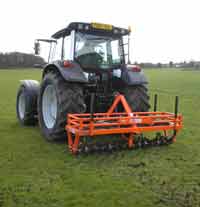
Aerating grassland is important, but what’s the best type of machine for it?
Compared with your average cereal crop, grassland has a pretty tough time of it.
While cereals are cosseted by having traffic routed along tramlines, grassland has heavy-hoofed livestock plodding all over it. Not only that, it also has to endure silage machinery, fertiliser spreaders, balers and slurry tankers and a host of other vehicular activity rolling across it.
No surprise to learn, then, that compaction is a common problem in grassland and one of the key reasons why it doesn’t perform to its full potential.
Not only is drainage and root development adversely affected, but the ability of the grass to utilise fertiliser is also put in jeopardy. A lack of oxygen means the availability of mineralised N from organic material in the soil is diminished and N fixation from legumes such as clover is also going to suffer.
Worse, perhaps, is that slurry applied to compacted grassland will not be absorbed readily and could lead to run off into waterways.
Regular aeration of grassland would appear to be a worthwhile operation and, for the improvements that can be expected, it is a relatively low cost operation. A contractor charge would be about £11.50/acre.
Aeration equipment generally falls into two types – slitters and subsoilers – and, at first glance, they don’t look the most sophisticated pieces of machinery on the farm.
But there’s more to their design than one might first imagine.
Ritchie
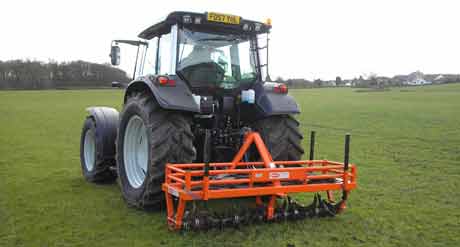
Take the Ritchie aerator, for example. Produced in working widths of 2.5m and 3m, it is equipped with boron blades that can be adjusted to an angle of 10°. This, says the company, increases the shattering effect on the compacted grassland.
A weight frame can be suitably loaded to help the blades to penetrate the ground when conditions are tough.
McConnel
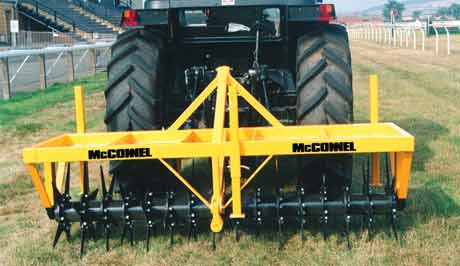
Similarly, McConnel’s Pasturator is also supplied in 2.5m and 3m working widths and fitted with boron blades. Working depth is put at 230mm, with a minimum power requirement of 40hp. There are 80 blades on the 2.5m version and 100 on the 3m. Interestingly, if the surface area of each blade is assumed to be a conservative 300sq cm (the total for both sides of the blade), 100 blades would result in slits providing a total of 3sq m of surface area for air to enter the soil and the grass root system, for every revolution of the rotor.
Which is quite impressive and, you would think, pretty advantageous for the welfare of the grass. But there is a school of thought that, while allowing access for air, slitting actually increases compaction.
Also worth mentioning is that grassland slitting is not supposed to be a one-off operation the full benefits of the job will only be realised after several years. So, many grassland farmers make slitting a regular part of their grassland management.
Aerway
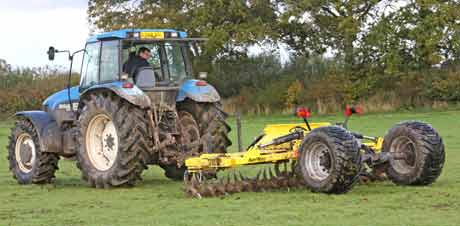
There are more than a few companies who make grass slitters. One of the newest on the scene is the Canadian company AerWay, which offers models in builds from 2.2m to as wide as 6m – and even wider on the home market.
It’s a heavyweight implement, which has sets of four-bladed star wheels grouped in a staggered formation on two rotors, each blade is 20cm long and is slightly angled so that the slot made is rather more than a blade width. Plenty of room for fresh air to enter these slits, reckons the company.
For more aggressive work – this implement is also designed to be a cultivator – the rotors can be set to run at up to 15°, which sees the soil being lifted and is clearly too severe for grassland aeration duties.
To absorb violent shocks the two rotors are mounted at each end by a large “C” spring. Excessive movement is prevented by chains.
OxyGenerator
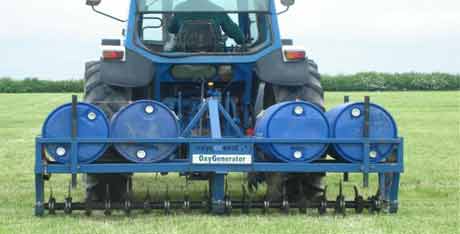
Also relatively new to the aerator scene is the OxyGenerator produced by the Glenside Group, which was introduced last year.
Looking for all the world as if it is carrying its own oxygen tanks – they are actually ballast tanks that can be filled with water – the implement is available in 3m and 5m working widths.
Use of solid steel shafts and self-aligning bearings are claimed to provide sufficient strength for the offset adjustment of the shaft and blades up to 5°, an action which increases the shatter effect of the blades.
The 5m version weighs in at 900kg, but this can be increased to 2.1t when fully ballasted.
Grassland subsoilers
Opico
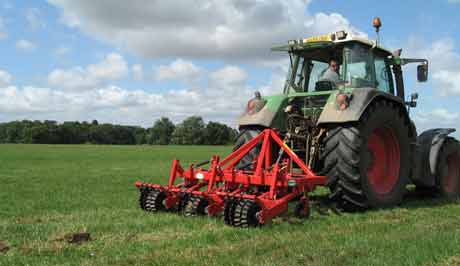
While grassland slitters do a good job, there are bigger implements that can be brought to bear should the degree of compaction warrant it.
Opico’s Sward Lifter is designed to break up pans and surface compaction, while lifting and opening up the subsoil to improve aeration and drainage.
The implement is, in effect, a subsoiler designed to work in grassland without disturbing the surface. Versions with working width of 2.7m and three legs, and 3m with five legs are available.
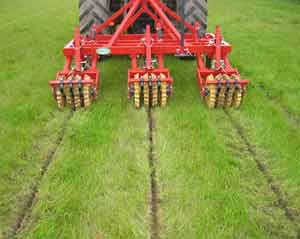
Preceding the subsoiler legs are discs that cut through the turf and prevent soil bursting through on to the surface. The legs themselves are shearbolt-protected as standard and with hydraulic reset if specified. Closing the slots made by the legs is a spring-loaded press roller.
Although the machine has been on the market for less than two years, the results to date are said to be good.
Opico boss James Woolway says that trials with the 2.7m, three-leg version during the autumn had proved that drainage was improved and damage from winter waterlogging was prevented.
“Waterlogging can kill off productive grasses allowing indigenous grasses to repopulate swards,” he says. “This results in degeneration of the sward quality and, as a result, the value of the sward.”
Power requirement is more than for slitters. The three-leg version is in the 100hp zone and the five-leg 125hp.
McConnel
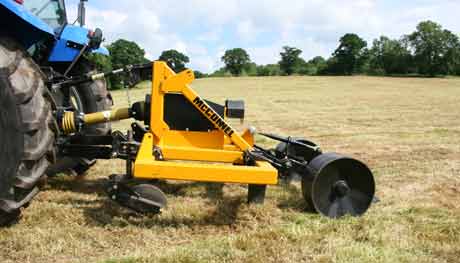
Using expertise gained in building its Shakaerator for the cultivation scene, McConnel also produces a version for use on grassland.
This version has a 2m working width and uses two 600mm legs, which are preceded by two spring-loaded discs to make the initial cut into the sward.
The legs are fitted with long-life replaceable points and shins and two rollers are responsible for sealing the slot after the legs.
McConnel claims that the vibration effect of the pto-powered vibro-unit provides a high level of deep soil conditioning to improve structure and drainage with the result that the grass performs to its full potential.
Power requirement for the Shakaerator is surprisingly low and is put at a minimum of 45hp.
Grassland aeration benefits
- Compaction relieved with the introduction of oxygen
- Aerated soils recover quicker after mowing
- Surface drainage improved – slurry and rainwater absorbed more quickly with run-off risk reduced
- Less poaching by livestock
- Increased root development
- Grass leys last longer
- Increased microbial action for better utilisation of fertiliser
- Improved N fixation for legumes such as clover

